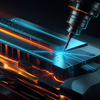
Why Precision Machining Is Essential for Modern Robotics
Discover how precision machining for robotics creates hyper-accurate components, boosting performance and efficiency. Learn the essential role of CNC in building the future of automation.

Find Top Custom CNC Machining Near You
Looking for custom CNC machining services? Learn to evaluate local shops based on capabilities, materials, and precision to find the right partner for your project.

Why CNC Machining for Consumer Goods Delivers Excellence
Discover how CNC machining for consumer goods transforms product quality. Learn about its precision, material versatility, and key applications for your business.

How to Select the Right CNC Plastic Material for a Project
Stop guessing on materials. Learn how to choose the right CNC plastic by evaluating mechanical strength, cost, and machinability for your application.

Multi-Axis Machining: How It Works and Its Key Benefits
Explore the fundamentals of multi-axis machining, an advanced process for creating complex parts. Learn how it works, its different types, and its key benefits.

CNC Machining Tolerances: Balancing Precision and Cost
Learn how to specify CNC machining tolerances effectively. Understand the critical trade-offs between precision, part function, and cost to optimize your designs.

Prototyping Electronics Enclosures: Methods & Key Steps
Learn the essential methods for prototyping electronics enclosures. This guide covers key design considerations, material choices, and manufacturing processes like 3D printing and CNC.

Expert CNC Plastic Fabrication Services for Your Project
Need high-quality custom plastic parts? Our CNC plastic fabrication services offer precision, speed, and a wide range of materials. Get a fast quote today.





